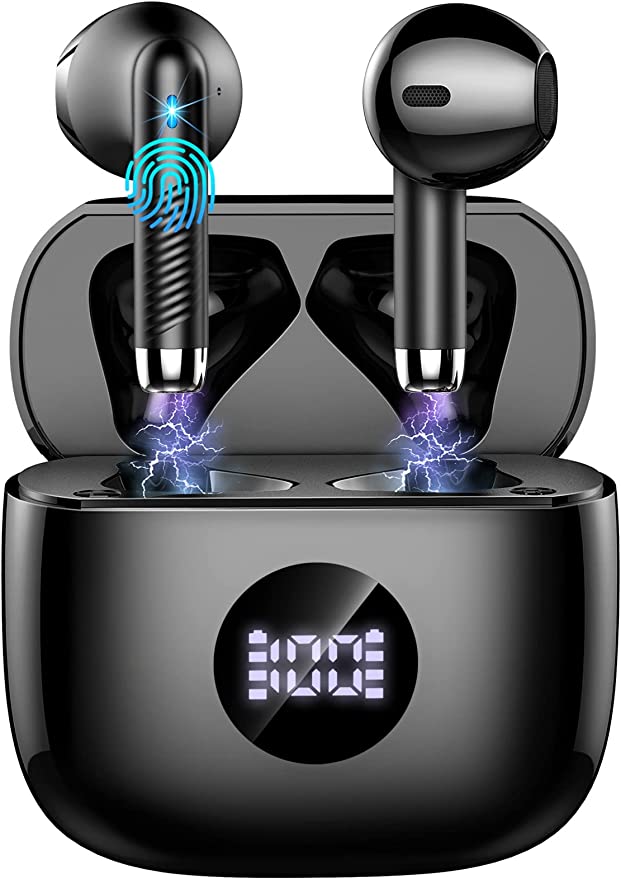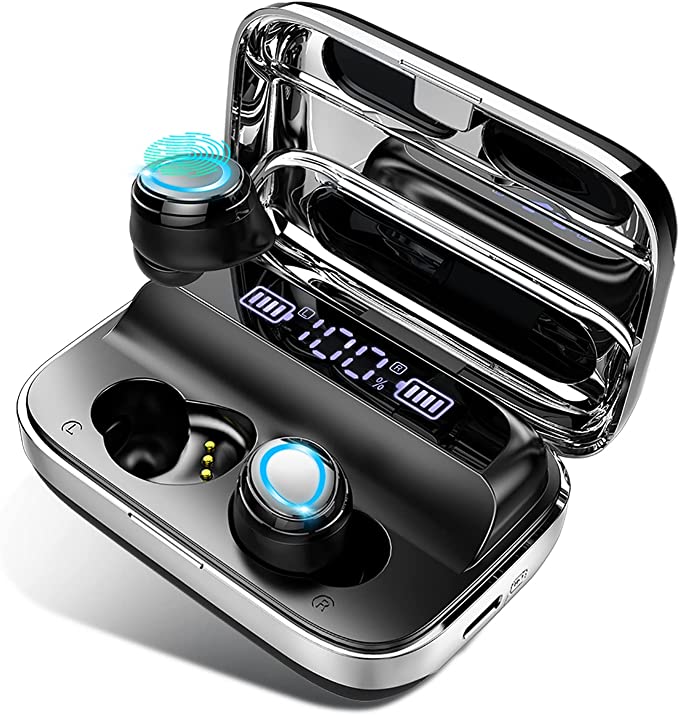We live in an era of untethered sound. Music follows us on runs, podcasts fill our commutes, and crucial calls happen mid-stride, all without the tyranny of tangled wires. Wireless earbuds, once a luxury, are now ubiquitous, seamlessly blending into the fabric of our daily lives. Products like the Jxrev J53-4 Wireless Earbuds represent this wave of accessible technology, promising a suite of modern features at an approachable price point. But beyond the marketing bullet points – Bluetooth 5.3, 13mm drivers, ENC Noise Cancelling, IP7 Waterproof – lies a fascinating interplay of science and engineering. As someone who delights in understanding how things work, let’s peel back the layers and explore the actual technology humming away inside these compact devices, using the J53-4 as our case study. What makes them connect, sing, listen, endure, and respond?

The Unbreakable Thread? Demystifying Bluetooth 5.3 Stability
The invisible lifeline of any wireless earbud is its Bluetooth connection. The J53-4 earbuds state they utilize Bluetooth 5.3. To appreciate what this means, let’s take a quick step back. Bluetooth technology, named rather whimsically after a Viking king known for uniting disparate tribes, began its journey in the late 1990s as a cable replacement standard. Its initial versions were relatively slow and power-hungry. Over two decades, it has evolved dramatically. We saw speed increases (EDR – Enhanced Data Rate), high-speed options (Bluetooth 3.0 + HS), and a major leap with Bluetooth 4.0’s Low Energy (LE) profile, crucial for small, battery-powered devices like earbuds.
Bluetooth 5.0 expanded range and speed, and subsequent minor revisions (5.1, 5.2, 5.3) have focused on refining the experience – think better location services, foundational support for next-generation LE Audio (in 5.2), and, importantly for version 5.3, incremental improvements aimed at enhancing connection reliability, reducing latency in certain scenarios, and improving power efficiency and security. It’s less about a single headline feature and more about optimizing the complex wireless dance between your earbuds and your phone or computer.
Imagine Bluetooth traffic as cars on a highway. Newer versions, like 5.3, don’t necessarily increase the speed limit drastically over 5.0/5.1/5.2 for audio streaming itself (which is often limited by audio codecs anyway), but they introduce smarter traffic management. This includes features that help devices select cleaner transmission channels more efficiently, potentially reducing interference from other wireless signals (like Wi-Fi or microwave ovens) and allowing the earbuds to spend less time actively transmitting or listening, thus saving power.
So, when the J53-4 description claims Bluetooth 5.3 enables transmitting signals “quickly and stably, with no delay or degradation,” the underlying technology aims to provide a more robust connection less prone to frustrating dropouts or stutters, especially in crowded wireless environments. This translates to a smoother listening experience, whether you’re streaming high-resolution audio or trying to maintain lip-sync during a video call. The “auto-reconnect” feature adds another layer of convenience. After the initial pairing ritual, the earbuds store the unique address of your device. Opening the case simply wakes them up and tells them to look for that familiar digital handshake – a small but significant quality-of-life improvement.

The Science of Sound: Making Waves with 13mm Dynamic Drivers
How does an object smaller than your fingertip fill your ears with sound, from the delicate strum of a guitar to the thumping beat of a bassline? The J53-4 employs 13mm dynamic speakers, a common and effective technology. At its core, a dynamic driver is a marvel of miniature engineering, operating on the same fundamental principle as the large cone speakers in your living room.
Think of it like a tiny, electrically powered drum. A voice coil (a loop of wire) is attached to a diaphragm (a thin, flexible membrane, the ‘drum skin’). This assembly sits within a magnetic field created by a permanent magnet. When an electrical audio signal (representing the music) flows through the voice coil, it becomes a temporary electromagnet. The interaction between this electromagnet and the permanent magnet creates a rapidly varying force that pushes and pulls the voice coil – and thus the diaphragm – back and forth at incredible speeds. These vibrations displace the air in front of the diaphragm, creating pressure waves that travel through the ear canal to your eardrum, which your brain interprets as sound.
The description highlights the 13mm size of these drivers. In speaker design, all else being equal, a larger diaphragm has the potential to move more air. Moving more air is particularly important for reproducing low-frequency sounds (bass), which require larger air displacements. Therefore, a 13mm driver might offer an advantage in bass response and overall loudness compared to smaller drivers (often found in the 6-10mm range). However, size isn’t the only factor, and perhaps not even the most important one. The diaphragm’s material, its stiffness and damping properties, the magnet’s strength, the voice coil’s design, and especially the acoustic tuning of the earbud’s enclosure play critical roles in the final sound quality. A well-tuned smaller driver can outperform a poorly implemented larger one.
The claim of “Hi-Fi stereo sound with crisp, clear high notes and deep, rich bass” is an aspiration rooted in using these larger drivers. “Stereo” simply means that distinct left and right audio channels are delivered to each ear, creating a sense of spaciousness and allowing you to perceive the positioning of instruments or sound effects – essential for an immersive listening experience. Achieving true “Hi-Fi” (High Fidelity) – accurately reproducing the original recording with minimal distortion – is a high bar for any audio device, especially compact earbuds, but the use of decently sized dynamic drivers provides a foundation upon which good tuning can build.

Can You Hear Me Now? Understanding ENC Noise Cancellation for Calls
While we enjoy immersive audio from our earbuds, clear communication through them presents its own set of challenges, especially in noisy surroundings. The J53-4 earbuds feature built-in microphones with ENC (Environmental Noise Cancellation), claimed to reduce ambient noise by up to 35dB for clearer calls.
It’s crucial to understand that ENC, in this context, primarily benefits the person you are calling. It’s focused on cleaning up the signal from your microphone before it’s transmitted. This is different from ANC (Active Noise Cancellation), which works to cancel out noise for your listening experience by generating anti-noise waves inside the earbud.
How does ENC work its magic? While the exact implementation can vary, it typically relies on multiple microphones built into each earbud. One or more microphones are positioned to primarily capture your voice, while others are strategically placed to pick up the surrounding ambient noise (traffic, wind, chatter). Sophisticated algorithms running on a tiny processor inside the earbud then analyze these signals. By comparing the voice-focused signal with the ambient noise signal, the system can identify and digitally subtract or filter out much of the unwanted background noise, leaving your voice relatively clearer and more intelligible for the listener on the other end. Think of it like a smart gatekeeper for the microphone, trying its best to only let your voice pass through while holding back the noisy crowd. Some advanced techniques involve “beamforming,” where the microphone array electronically steers its sensitivity towards the direction of your mouth.
The claim of reducing noise by “up to 35dB” is a specific performance metric provided in the description. Decibels (dB) represent a logarithmic scale, so a 35dB reduction is substantial if achieved. However, such figures are usually obtained under specific laboratory conditions with particular types of noise. Real-world performance will inevitably vary depending on the nature and loudness of the background noise, wind conditions, and how well the earbuds are positioned. Nonetheless, effective ENC can make a significant difference in call quality, turning a frustrating conversation shouted over street noise into a more pleasant and productive exchange, whether for a crucial business call or just catching up with friends.

Weathering the Elements: What IP7 Waterproofing Really Means
Life is unpredictable. A sudden downpour during your run, an accidental splash by the sink, or just the inevitable sweat during intense exercise – moisture is a constant threat to delicate electronics. The J53-4 addresses this with an IP7 waterproof rating. What does this code actually signify?
“IP” stands for Ingress Protection, and it’s an international standard (IEC 60529) used to classify the degree of protection provided by enclosures of electrical equipment against intrusion from solid objects (like dust) and liquids (water). The rating usually consists of two digits. The first digit relates to solid particle protection (ranging from 0 to 6). The second digit relates to liquid ingress protection (ranging from 0 to 9K).
Sometimes, you’ll see an ‘X’ used for one of the digits (like IPX7), which simply means the device wasn’t specifically tested or rated for that category (in the case of IPX7, solid particle protection isn’t rated). The J53-4 description states “IP7,” which might imply some level of dust protection, but the crucial part for most users is the ‘7’ concerning water.
An IPX7 rating means the device is protected against the effects of temporary immersion in water. Specifically, the standard requires that water shall not enter in a quantity sufficient to cause harmful effects when the enclosure is immersed in water under defined conditions of pressure and time – typically, up to 1 meter (about 3.3 feet) of submersion for up to 30 minutes. The product description also mentions an internal “IP7 waterproof nano-coating” applied to components. This is often a superhydrophobic (water-repelling) layer, invisible to the eye, that encourages water to bead up and roll off, providing an additional line of defense.
What does this mean practically? IPX7-rated earbuds like the J53-4 should comfortably handle sweat from workouts, being worn in the rain, or even surviving an accidental drop into a puddle or sink, provided they are retrieved quickly. However, it’s important to understand the limitations. IPX7 does not mean the device is suitable for swimming (which involves prolonged immersion, pressure variations, and often chemicals like chlorine), showering (where hot water and soap can compromise seals, and water jets add pressure), or exposure to high-pressure water sprays. It’s about resilience against common accidental encounters with water, offering valuable peace of mind for active users.
Fueling the Freedom: Batteries, Playtime, and the Clarity of LEDs
All this wireless technology needs power. The J53-4, like most modern portable electronics, relies on Lithium Polymer (Li-Po) batteries. Li-Po is a type of Lithium-ion battery that uses a polymer electrolyte instead of a liquid one. This allows for more flexible form factors (useful for fitting batteries into tiny earbuds) and generally good energy density (amount of energy stored relative to weight/volume).
The product description presents impressive playtime figures: up to 8 hours from the earbuds on a single charge, with the charging case holding approximately 4 additional recharges, leading to a total claimed playtime of around 40 hours. It’s vital to remember that these figures are usually best-case scenarios, typically measured at moderate volume levels using efficient audio codecs. Cranking up the volume, using power-hungry codecs, maintaining a connection in a weak signal area, or frequently using features like ENC can reduce actual playtime. Still, 8 hours per charge is solid for earbuds, and a total of 40 hours means many users could potentially go several days, or even a week, between needing to charge the case itself via its USB-C port.
One particularly user-friendly feature highlighted is the LED Power Display on the charging case. While many cases have simple indicator lights, this one is described as showing the remaining battery percentage of the case and the charging status of each individual earbud. This granular information is surprisingly helpful. It eliminates the guesswork (“Is the left one fully charged yet?”) and allows users to manage their power more effectively, preventing the unpleasant surprise of one earbud dying mid-listen. The claimed 1-hour charging time (presumably for the earbuds within the case) is also relatively quick, minimizing downtime.

The Finishing Touches: Ergonomics and Control at Your Fingertips
Technology is only truly useful if it’s comfortable and easy to interact with. The J53-4 features an “ergonomic semi-in-ear” design. Finding a universally comfortable earbud fit is notoriously difficult due to the vast diversity of human ear shapes and sizes. A semi-in-ear design typically sits just at the entrance of the ear canal, rather than sealing deep inside like traditional in-ear monitors with silicone tips. This can feel less intrusive for some users but might offer less passive noise isolation and potentially a less secure fit for vigorous activity compared to deep-insertion designs. The stated weight of only 3 grams per earbud (roughly the weight of a US penny) is certainly light and contributes significantly to reducing wearing fatigue over extended periods.
Interaction is handled via touch controls integrated into the earbuds’ outer surface. This eliminates the need for physical buttons, which can sometimes be fiddly or push the earbud uncomfortably into the ear when pressed. These touch-sensitive areas allow users to perform actions like playing/pausing music, adjusting volume, skipping tracks, answering/ending calls, or activating their phone’s voice assistant (like Siri or Google Assistant) with simple taps or holds – all without needing to pull out their phone. The ability to use either earbud independently in mono mode is another practical touch, useful for taking calls while needing to stay aware of surroundings with the other ear, or simply extending battery life by alternating buds.

Accessible Innovation: Democratizing the Wireless Experience
Exploring the technology packed into the Jxrev J53-4 reveals a microcosm of the trends shaping modern consumer electronics. We see the steady refinement of core wireless protocols like Bluetooth 5.3, aiming for ever more reliable connections. We observe the application of acoustic principles in dynamic drivers, striving to deliver better sound from smaller packages. We witness the clever use of signal processing in ENC to tackle the persistent problem of background noise during calls. We benefit from standardized durability ratings like IPX7, offering resilience against the rigors of daily life. And we appreciate the user-centric conveniences of long battery life, informative displays, and intuitive controls.

What’s perhaps most significant is how these technologies, many of which were confined to premium, high-cost devices just a few years ago, are now filtering down into more accessible products. This democratization of technology empowers users, allowing more people to enjoy the freedom and convenience of truly wireless audio. While no single product is perfect, understanding the science and engineering behind the specifications allows us to appreciate the intricate symphony of components working together in these tiny devices, enriching our daily soundscape in ways we now almost take for granted. It’s a reminder that even in the most commonplace gadgets, there’s often a remarkable amount of ingenuity quietly at play.




